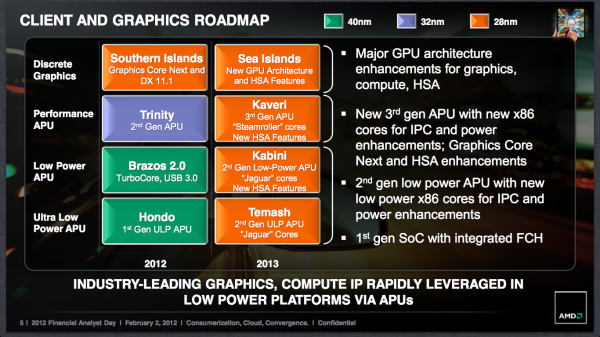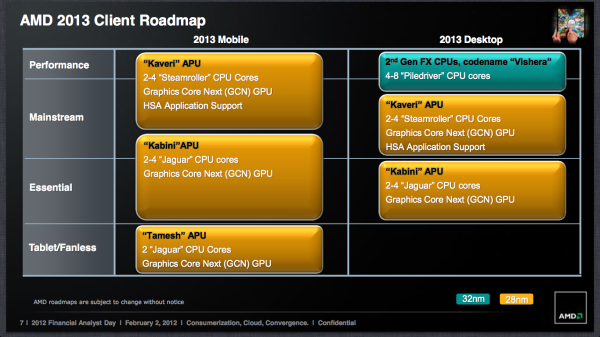Understanding AMD's Roadmap & New Direction
by Anand Lal Shimpi on February 2, 2012 6:16 PM EST- Posted in
- CPUs
- AMD
- Trade Shows
- AMD FAD 2012
We've been providing live coverage of AMD's 2012 Financial Analyst Day from Santa Clara today, but if you want a summary of the company's strategy under new CEO Rory Read you've come to the right place. Below you'll find links to everything we've published from AMD's FAD 2012:
AMD's Rory Read Outlines AMD's Future Strategy
AMD Outlines HSA Roadmap: Unified Memory for CPU/GPU in 2013, HSA GPUs in 2014
AMD is Open to Integrating 3rd Party IP in Future SoCs
AMD's Financial Analyst Day 2012 - Mark Papermaster, SVP & CTO Presentation
AMD: Flexible Around ISA
AMD Nods at Shorter Design Cycles, More Synthesized Designs
What AMD Views as Important: Tablets, Servers, Notebooks & GPUs
AMD & Compal Show Off 18mm Trinity Notebook
AMD's 2012 - 2013 Client CPU/GPU/APU Roadmap Revealed
AMD's 2012 - 2013 Server Roadmap: Abu Dhabi, Seoul & Delhi CPUs
AMD is Ambidextrous, Not Married to Any One Architecture, ARM in the Datacenter?
AMD's Tablet Architectures: Hondo at 4.5W, Future Sub-2W SoC
The name of the game for AMD in 2012 is execution. Far too often at previous AMD events we'd see a roadmap with no indication of whether or not AMD would actually stick to it. Plans were always aggressive and made sense, but execution rarely mirrored what was promised on paper. AMD in turn ended up delivering CPUs sometimes years after they were promised, which obviously didn't help grow the company.
Over the past few months Rory and his new management team at AMD have been restructuring the company to improve execution. As a much smaller company than Intel, AMD had an almost impossible task competing in the x86 space, but AMD should have also been far more agile than it was given its size. AMD's restructuring is supposed to fix these agility and execution problems. The proof will be in how well AMD is able to introduce products over the next 24 months.
As far as the roadmap goes, AMD already laid out what it hopes to accomplish by 2013. The best way to summarize AMD's next two years is: APUs and servers. On the APU side, we'll get updates to all of the current lines this year (Trinity & Brazos 2.0), but we'll also get a new 4.5W APU (Hondo) aimed at the Windows 8 tablet market. Now 4.5W is a bit high for a tablet but AMD has plans to bring even lower power architectures to market in the future. Next year we'll also see the first single-chip solutions from AMD: Kabini and Temash will integrate the I/O controller (SATA, USB ports, etc...) on-die. Intel is doing something similar with Haswell.
The big transition will happen next year, as AMD moves its entire APU stack from 32nm SOI to a bulk 28nm process at Global Foundries. This is an important move as it signifies the use of more easily synthesized designs, which enables AMD to bring out APUs in a quicker fashion and with lower design costs. Effectively everything follows the path laid by Brazos/Bobcat at this point. Note that AMD will be shipping 28nm APUs while Intel is well transitioned to 22nm, a gap that AMD has no intentions on narrowing. The process technology gap has almost always existed between AMD and Intel, but now AMD is taking a firm stance in saying that it has no intentions to blindly pursue the closing of that gap.
What once was a 3+ year design cycle for AMD CPUs and APUs now shrinks to less than 24 months (maybe even as short as 18 months) as a result of this migration to more easily synthesized designs. If this sounds a lot to you like the old GPU design cadence don't be surprised. AMD's APUs are, after all, largely made of GPU transistors that have always strayed from custom logic where possible. The big change is simply doing more non-custom x86 design.
Obviously AMD's ability to execute on this roadmap will depend heavily on Global Foundries delivering good yields at 28nm, however AMD does seem fairly confident at this point. That being said, 2013 is a very broad timeframe. Executing on the above roadmap sooner rather than later in 2013 will be the difference between a competitive AMD and one that's quickly written off.
I don't believe a move towards easily synthesized architectures is necessarily a bad thing. As long as AMD can deliver good performance at competitive prices the process technology really doesn't matter as much. Typically process technology was used as an enabler of good performance but as a newly fabless semiconductor, that strategy doesn't necessarily apply to AMD - at least not across all market segments. In other words, what works for Intel may not work for AMD.












84 Comments
View All Comments
arjuna1 - Friday, February 3, 2012 - link
Yeah yeah, the butt hurt one reporting, you can't understand because you weren't into brand loyalty, I did have an "arbitrary affinity" for AMD products, heck, I still do, but I certainly did get into building systems recently.I'm glad you want an APU in your next desktop build, I do not, if I did I would be looking to purchase a laptop or any other mobile device.
I want to empathize again, I get it that it's healthy for AMD to focus on where the money is, but doing so at the expense of they desktop offerings is forgetting about those of us who helped build and sustained AMD phenom II point.
There is no other projected desktop CPU other than Vishera, and that on itself is a low end server part being sold as a high end part, the 3rd generation BD will go to Kaveri, which is an APU.
If that does not sound like forfeiting the game, I don't what does, even Anand acknowledges AMD is out of the high end desktop CPU race.
B-Unit1701 - Friday, February 3, 2012 - link
AMD is not 'forgetting' those who got them here, they are finnaly ending their torture. For years we've been waiting with huge erections for the unveiling of AMDs newest, and then get let down with sad, sad performance. They are ending the cycle of pain and going towards what they do well instead. I say good deal, make some money and improve.mhahnheuser - Friday, February 3, 2012 - link
What is missed in all this discussion is that Llano is a far far better purchase out of the box than Sandybridge, not just better, AMD first daylight second and Intel some distance back in the dust. It's only when you add a third party GPU that SB even gets in the picture.Why would AMD want to put all this effort and expense chasing ultra low volume, outright single core IPC performance and get peanuts for it when it can get uber-prices for stand alone GPU's of which they are currently pulling around 50% of the Intel platform. It's the GPU which provides the uber performance not the CPU, and a 7970, 50 0r 90 will make more than double the money for AMD than a Bulldozer CPU that can manage to outperform a SB-E by 10 FPS with the same high end GPU.
They're (AMD) in a pretty good space to persue more lucrative market segments.
frozentundra123456 - Saturday, February 4, 2012 - link
I see no reason at all to purchase llano on the desktop. Just get an Intel CPU for better performance and add a discrete 50.00 card if you want good graphics. If I were buying a laptop I would probably get llano, but on the desktop it is mediocre at everything, and a discrete card is a much better solution.seapeople - Saturday, February 4, 2012 - link
That's the same thing as saying a 10-speed bicycle is a far far better purchase out of the box than a Porsche 911. It's only until you add a third party combustible hydrocarbon that the Porsche 911 becomes a better means of transport.mhahnheuser - Friday, February 3, 2012 - link
...and just for good measure, with Intel chasing the gamer enthusiast market is actually doing AMD's work for them in driving aplications toward increased GPU performance, which long term has got to be in AMD's interest, given their future plans for more GPU utilisation, so theirs is not a dumb strategy to let Intel do most the heavy lifting in the enthusiast segment.dicobalt - Saturday, February 4, 2012 - link
Intel will be rolling out 14nm in 2014. AMD really needs to get Globalfoundries to speed up. It's really disappointing to hear AMD isn't interested in competing on process. I can't see AMD as being able to compete.rocketbuddha - Saturday, February 4, 2012 - link
Worse is that AMD has no advantages other than being fabless.a) Its die-size at similar nodes is bigger than competition
b) Reduces yields.
c) No longer a tight coupling with the foundries. Going forward I see GF not neccessarily accomodating AMD's concerns on Node race.
While I am disappointed I think Rory Read made the right decision with the cards he has been dealt with. AMD should be extra smart....
tipoo - Monday, February 6, 2012 - link
I don't think AMD has that kind of pull at GloFo anymore. They got rid of most of the controlling share, if I recall.Rictorhell - Saturday, February 4, 2012 - link
Wow. I've been a computer fan for years now and suddenly, people care more about cellphones and smartphones then they do about actual computers. When did that happen? How is it that the internet has been popular for years now, but yet, very little has actually changed? The technology still feels slow to me, in many ways.We have Facebook and Twitter and Youtube, yeah, but are these really exciting and amazing advancements in technology? I've read and heard reports that there just aren't many people taking up computer science and computer programming and from what I have seen, I can kind of believe those reports.
Unless, the majority of people that are really interested in working in the computer field are focusing mainly on videogames or IT.
I don't really have anything against smartphones, except the fact that to really get a good amount of use and enjoymment out of them, you have to sign a contract with Verizon or some other service provider. I love PDAs and I still use one, I just wish there was an interest in developing modern PDAs that did not require monthly payments or contracts.
I like the idea of things like the Ipod Touch and the Samsung Galaxy Player, but both of those pieces of hardware are basically inferior to their smartphone counterparts, created by the same companies.
What if I want a device with the same quality of screen as the Iphone 4 or the Samsung Galaxy Nexus, but I just don't want to sign a contract? If I am willing to pay for a quality gadget, I would hope that someone out there would be willing to build it, but that doesn't seem to be the case.
I kind of see tablets as a bigger and better version of PDA, but I need something with a decent amount of storage space and processing power.
The upcoming WIndows 8 tablets might be just what I am waiting for, but I am hoping for some actual innovation and creativity and not just a more mobile version of what I already have.